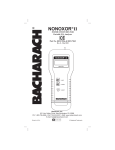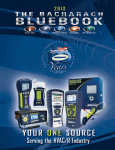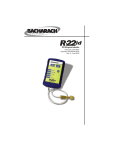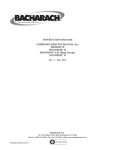Download Bacharach Monoxor III Specifications
Transcript
® MONOXOR II INSTRUCTION 0019-9113 Portable CO Analyzer Part No. 0019-7034 & 0019-7039 Rev. 8 - May 2010 Bacharach, Inc. 621 Hunt Valley Circle, New Kensington, PA 15068 PH: 1-800-736-4666 • FAX: 724-334-5001 • Web: www.mybacharach.com E-mail: [email protected] Printed in U.S.A. ® Registered Trademarks WARRANTY Bacharach, Inc. warrants to Buyer that at the time of delivery this Product will be free from defects in material and manufacture and will conform substantially to Bacharach Inc.’s applicable specifications. Bacharach’s liability and Buyer’s remedy under this warranty are limited to the repair or replacement, at Bacharach’s option, of this Product or parts thereof returned to Seller at the factory of manufacture and shown to Bacharach Inc.’s reasonable satisfaction to have been defective; provided that written notice of the defect shall have been given by Buyer to Bacharach Inc. within one (1) year after the date of delivery of this Product by Bacharach, Inc. Bacharach, Inc. warrants to Buyer that it will convey good title to this Product. Bacharach’s liability and Buyer’s remedy under this warranty of title are limited to the removal of any title defects or, at the election of Bacharach, to the replacement of this Product or parts thereof that are defective in title. All expendable items, such as electrochemical sensors, are warranted for a period of six months. THE FOREGOING WARRANTIES ARE EXCLUSIVE AND ARE GIVEN AND ACCEPTED IN LIEU OF (I) ANY AND ALL OTHER WARRANTIES, EXPRESS OR IMPLIED, INCLUDING WITHOUT LIMITATION THE IMPLIED WARRANTIES OF MERCHANTABILITY AND FITNESS FOR A PARTICULAR PURPOSE: AND (II) ANY OBLIGATION, LIABILITY, RIGHT, CLAIM OR REMEDY IN CONTRACT OR TORT, WHETHER OR NOT ARISING FROM BACHARACH’S NEGLIGENCE, ACTUAL OR IMPLIED. The remedies of the Buyer shall be limited to those provided herein to the exclusion of any and all other remedies including, without limitation incidental or consequential damages. No agreement varying or extending the foregoing warranties, remedies or this limitation will be binding upon Bacharach, Inc. unless in writing, signed by a duly authorized officer of Bacharach. Declaration of Conformity Manufacturer's Name: Manufacturer's Address: Bacharach, Inc. 621 Hunt Valley Circle New Kensington, PA 15068 Product Name: MONOXOR II Conforms to the following product specifications EMC: A European Directive 89/336/EEC EN 500081-1 (Emissions) EN 500082-1 (Immunity) Copyright © 1995-2010 Bacharach, Inc. WARNING! Because this instrument is used to detect and monitor materials and conditions which are listed by OSHA or others as potentially hazardous to personnel and property, the information in this manual must be fully understood and utilized to ensure that the instrument is operating properly and is both used and maintained in the proper manner by qualified personnel. An instrument that is not properly calibrated, operated and maintained by qualified personnel is likely to provide erroneous information, which could prevent user awareness of a potentially hazardous situation for the instrument user, other personnel and property. If, after reading the information in this manual, the user has questions regarding the operation, application or maintenance of the instrument, supervisory or training assistance should be obtained before use. Assistance is available by calling your nearest Bacharach Service Center. 1 INTRODUCTION The Monoxor® II is a commercial-grade portable instrument designed to display concentrations of carbon monoxide (CO) gas between 0 and 2000 ppm. This instrument shows the presence of CO in a gas sample by drawing the sample into its sensor chamber by a built-in motorized pump. Part #0019-7034 comes with a probe. Part #0019-7039 comes without a probe (All non-probe related functions remain the same in this instruction). Figure 1. Monoxor II Other features and accessories of the Monoxor II include: A large, back-lit Liquid Crystal Display (LCD), which allows the display to be read in any lighting condition from direct sun-light to total darkness; a semi-detachable elastic strap that permits the instrument to be either hand held, or hung on nearby objects; a rigid stainless steel probe with handle, connected to a flexible hose that allows gas samples to be taken from cramped and confined areas (alternate probes and condensate traps may be used). 1 2 TECHNICAL CHARACTERISTICS CO Display Range ............... 0-1999 ppm CO Accuracy .............................. ±10 ppm or ±5% of reading whichever is greater* Response Time ..................... 90% of final value within 40 sec. Battery Requirements........... 1.5 V, “C” cells, Qty. 4 Operating Time** ................ 14 to 16 hours, alkaline cells Operating Temp. Range ....... 23 to 104°F (–5 to 40°C) Relative Humidity ................ 10 to 85% non-condensing Weight (w/o batteries) .......... 12 ozs. (341 grams) Dimensions .......................... 8.6 x 3.5 x 2.9 in. (218 x 89 x 74 mm) * Tighter accuracy in the lower ranges, up to ±2 ppm, may be attained if lower range calibration gases (eg. 100 ppm) are utilized. ** Times are with the backlight turned off. Continuous use of the backlight will decrease battery life. 3 PREPARING THE MONOXOR II FOR OPERATION To prepare the instrument for operation, you must install four “C” size batteries, and (if desired) install the hose and probe as described in the following paragraphs. For your convenience, and to ensure that the instrument will provide reliable CO indications, the CO sensor is installed and the instrument calibrated on 500 ppm of CO at the factory. 3.1 Battery Installation Detach the elastic strap's metal clip at the bottom of the instrument, and slide off the battery cover as shown in Figure 2. Then while observing proper battery polarity, install four “C” size batteries into the instrument’s battery compartment. (Recommended battery types: Duracell Alkaline or equivalent). After the batteries are installed, replace the battery cover and the elastic-strap clip. Figure 2. Battery Installation 2 If batteries are accidently installed in the wrong polarity, a positive temperature coefficient (PTC) thermistor will protect the instrument’s electronic circuitry. The instrument will operate once batteries are properly installed and the PTC thermistor is allowed to cool. 3.2 Probe Installation Install the probe by sliding the end of its tubing over the gas inlet port on the top right side of the instrument as shown in Figure 3. The tubing may be difficult to slide over the gas inlet port of the unit for the first time. This was done intentionally to allow for a snug fit. If necessary, use a little dish washing liquid diluted in water or heat the end of the tube with hot tap water to help it slide onto the port. GAS INLET PORT LINE DRYER PROBE HANDLE When changing probe tubes, hand tighten nut, and then use a wrench to tighten ≈1 flat to seal. Figure 3. Probe Installation 3 4 OPERATION To operate the Monoxor II, you simply . . . • Set its POWER switch to ON, • Wait for the instrument to warm up (approx. 1 minute), • Zero the display (if necessary), • Take a gas sample. Detailed operating procedures are presented below: 4.1 Power ON/OFF Turn on the instrument by sliding its POWER switch to ON. Observe that when power is first applied, all numerical LCD segments are tested for 5–15 seconds; after which, the LCD shows the detected CO level. (A minus sign may appear during power up as the sensor stabilizes.) Turn off the instrument by sliding the POWER switch to OFF. Important! When storing the instrument for extended periods of time, remove the batteries and ensure that the POWER switch is OFF. The OFF position places a short across the CO sensor, thus keeping the sensor from being destabilized while not in use. 4.2 Zeroing the Instrument After being turned on and warmed up for at least 1 minute, the instrument should indicate 000 ±5 ppm in fresh air. If the instrument needs to be zeroed, proceed as follows: 1. Ensure that the instrument is sampling air that is free of Carbon Monoxide. NOTE: If the instrument was zeroed in an area where CO was present, a large negative CO display appears. 2. Using a 1/8" flat-blade screwdriver, turn the ADJUST potentiometer until the LCD shows 0 ppm. The display shows negative numbers for zeroing purposes. An instrument can be considered zeroed with a display bounce of up to ±3 ppm. 4 4.3 Backlight ON/OFF The LCD can be read in low-light areas by setting the front panel LIGHT switch to ON. The backlight stays on until turned off, or until the POWER switch is set to OFF. 4.4 Using the Strap The instrument's elastic strap allows the unit to be either hand-held, or hung on nearby objects. By sliding your hand between the instrument and its elastic strap, you can hold onto the Monoxor II with a minimum of effort. The instrument's front panel slide switches can then be actuated by your thumb for one-handed operation. Or, by releasing the metal clip at the bottom of the instrument's case, you can hang the instrument by its strap on nearby objects such as nails, sheet metal, or valve handles. 4.5 Using the Probe A rigid stainless steel probe with handle is used to draw a gas sample from the room, grilles, diffusers, and furnace flues through a line dryer and flexible hose into the instrument. A flexible probe option (see Section 6) is available to give easy access to hot-water heater flues and inside furnace heat exchangers. The probe tube is detachable from the handle when sampling with a different probe is desired. See Figure 3. Important! The line-dryer will remove moisture from the gas sample. If the line-dryer becomes saturated, however, condensation may be observed within the hose. If this occurs, stop sampling and replace the line-dryer's filter-packing material. 4.6 Interpreting the Display Gas Display The LCD shows CO levels in the range from 0 to 1999 ppm. The display on the right indicates a CO level of 500 ppm. 5 Overrange When the gas sample exceeds 1999 ppm, a “1” is displayed on the LCD. To clear an overrange condition, leave instrument turned on and sample fresh air until the LCD returns to displaying CO. Low Battery Indications When the battery voltage becomes low, the “LO BAT” indicator appears. Although the instrument will continue to operate and give CO readings under these conditions, the batteries should be replaced as soon as possible. When battery voltage becomes too low for the instrument to operate, a “-1” is displayed on the LCD. No CO readings are provided under these conditions. 4.7 Long-Term Storage When storing the Monoxor II for extended periods of time, set its POWER switch to OFF and remove the batteries. The POWER OFF position places a short across the CO sensor, thus keeping it from being destabilized while not in use. 5 MAINTENANCE The Monoxor II needs to be calibrated at regular intervals to be certain that it still meets its accuracy specification. A regular calibration schedule should be established between you and your nearest Bacharach Service Center, unless your facility has the necessary calibration equipment and personnel trained in the maintenance of gas-detection equipment. Detailed calibration , maintenance procedures and replacement parts lists are provided in the Service Manual (0019-9166). As a quick check of the instrument’s operation, perform a response check by exposing the instrument to a source of CO (e.g., cigarette smoke, smoke from a recently snuffed-out match, bottled CO). If the instrument doesn’t show the presence of CO, or if the reading is obviously in error, DO NOT use the instrument until it has been serviced by an authorized Bacharach Service Center. NOTE: DO NOT use this simple response check as a substitute for ensuring the instrument is properly calibrated. 6 6 PARTS / SERVICE 6.1 Parts/Accessories List Item Part No. Battery Cover Probe/Hose/Line Dryer Assy. Flexible Probe Tube (optional) Line Dryer Filter Packing 0019-3029 0019-3084 0019-3104 0011-0122 6.2 Bacharach Sales / Service Centers United States Canada Bacharach, Inc. 621 Hunt Valley Circle New Kensington, PA 15068 Phone: 724-334-5051 Fax: 724-334-5723 Email: [email protected] Bacharach of Canada, Inc. 20 Amber St. Unit #7 Markham, Ontario L3R SP4 Canada Phone: 905-470-8985 Fax: 905-470-8963 Email: [email protected] 7 7 HAZARDS OF CARBON MONOXIDE Carbon monoxide poisoning results in headache, nausea, chronic tiredness, confusion, dizziness, and sometimes coma or death. It effects people by cutting off the supply of oxygen to their muscles and brain. The harmful effects of carbon monoxide exposure depend on both the concentration of CO in the air and the length of exposure. Concentration of CO in air Inhalation time and toxic symptoms developed 50 ppm* (0.005%) Maximum allowable concentration for continuous exposure in any 8-hour period. 200 ppm* (0.02%) Slight headache, tiredness, dizziness, nausea after 2–3 hours. 400 ppm (0.04%) Frontal headaches within 1–2 hours, life-threatening after 3 hours. 800 ppm (0.08%) Dizziness, nausea and convulsions within 45 minutes. Unconsciousness within 2 hours. Death within 2–3 hours. 1,600 ppm (0.16%) Headache, dizziness and nausea within 20 minutes. Death within 1 hour. 3,200 ppm (0.32%) Headache, dizziness and nausea within 5–10 minutes. Death within 30 minutes. 6,400 ppm (0.64%) Headache, dizziness and nausea within 1–2 minutes. Death within 10–15 minutes. 12,800 ppm (1.28%) Death within 1–3 minutes. For more information on CO ask about Bacharach's CO Regional Training Seminars. *Maximum CO concentration for exposure at any time as prescribed by OSHA. Effects can vary significantly based on age, sex, weight and overall state of health. 8





















